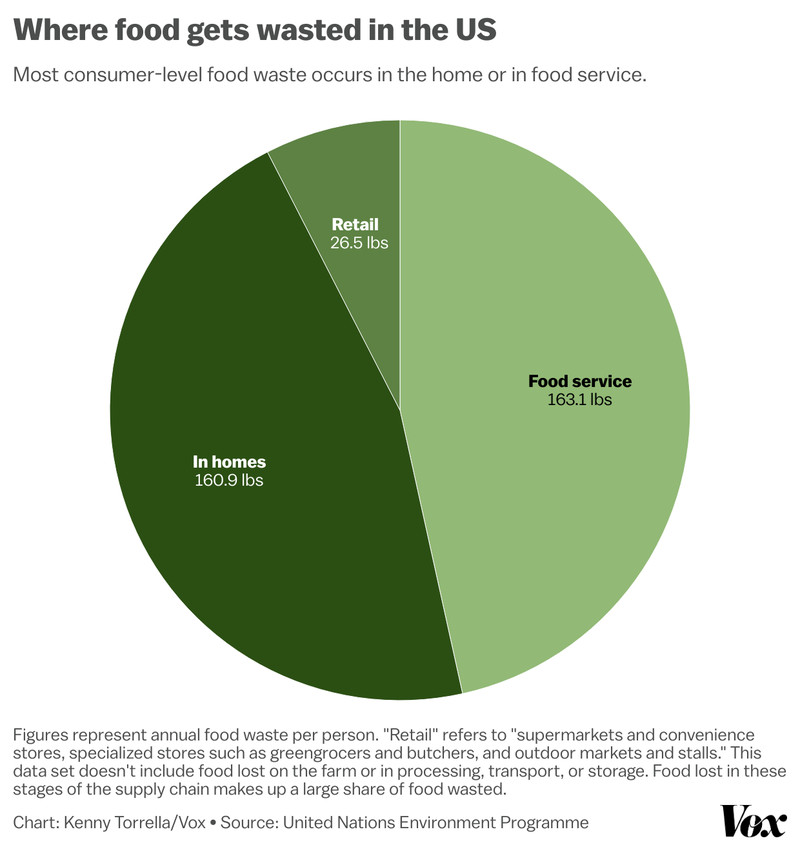
Think twice before throwing out your leftovers
A billion meals are wasted every single day, according to a recent report from the United Nations. And that’s a conservative estimate.
It’s not just food down the drain, but money, too. The 2024 UN Food Waste Index report — which measured food waste at the consumer and retail level across more than 100 countries — found that over a trillion dollars worth of food gets thrown out every year, from households to grocery stores to farms, all across the globe.
Such waste takes a significant toll on the environment. The process of producing food — the raising of animals, the land and water use, and the subsequent pollution that goes with it — is horribly intensive on the planet. Food waste squanders those efforts, and then makes it worse: as it rots in landfills, it creates methane, a powerful greenhouse gas. Food waste alone is responsible for an estimated 8 to 10 percent of global greenhouse gas emissions, according to the report. To put that into perspective, if food waste were a country, it would be third in emissions produced, behind only the United States and China.
Perhaps the most immediate harm, though, is the more than 780 million people who went hungry around the world in 2022, even as hundreds of billions of meals were wasted that same year. The world has become more efficient at producing a lot of food, so much so that there’s more than enough to go around for everyone. But in 2022, nearly 30 percent of people were moderately or severely food insecure, defined by the Food and Agricultural Organization as lacking regular access to safe and nutritious food.
Food waste reduction is “an opportunity to reduce costs and to tackle some of the biggest environmental and social issues of our time: fighting climate change and addressing food insecurity,” the authors of the report write.
Food waste might seem like an easy problem to solve — just stop wasting food. But in order to snuff food waste out, individuals, businesses, and policymakers alike will need to make some serious changes — and those changes will look different for each country. Global food waste is not just a consumer-level problem, but also a nasty side effect of inefficient food systems that have environmental and social implications.
The UN has the goal of slashing food waste in half by 2030. For that to happen, the authors of the Food Waste Index say there’s one crucial step all countries need to do: data collection. You can’t stop wasting food until you know how much food you’re wasting.
How do you measure food waste?
According to the report — which was spearheaded by the UN Environment Programme (UNEP) and co-authored by the Waste and Resources Action Programme (WRAP), a UK-based climate organization — households contributed to 60 percent of all food waste generated globally in 2022, compared to nearly 28 percent for food service and a little under 13 percent for retailers. However, it’s important to note that there was a lot more usable data for food waste in households than there was for food service or retail — and that’s especially true for low-income and middle-income countries.
The report uses a three-level methodology with each level increasing in accuracy and utility. The first level is an estimate using preexisting food waste data from countries. For countries that haven’t yet started collecting data on food waste, UNEP took data from other nearby countries that had similar income levels and then extrapolated that information to create estimates. These figures are a helpful start to understanding the scale at which food waste may exist in a country, but the report emphasizes that most of the Level 1 estimates are not accurate enough to use beyond that.
To clarify which estimates can be used for understanding the scale of a problem and which can be used beyond that, the report also assigned a “confidence” rating to each Level 1 estimate — high, medium, low, very low, or no rating. Only 11 countries were assigned a high confidence rating for household food waste estimates. Of these, Saudi Arabia had the highest amount of household food waste per person annually, at a little over 231 pounds per person. Bhutan had the lowest, at just under 42 pounds per person.

The next two levels of the methodology lay out a framework in which countries can track their food waste generation. Level 2 is the recommended, baseline approach for countries and requires an actual measurement, rather than just an estimate, of food waste that is suitable for tracking food waste at a national level. Level 3 goes beyond that and gives guidances for how countries can include additional helpful data, like where wasted food goes, how much of food waste is edible, and food loss from manufacturing.
While some organizations and institutions define food waste as edible food mass, the report includes both the edible and inedible parts of food. That may make it seem as if the estimations are inflated, but what’s considered edible and inedible can differ from culture to culture — think peels of fruits, or certain parts of animal meat. They also acknowledge that it’s difficult to measure edible food waste without also measuring the inedible parts, and most countries haven’t done so.
Notably, the report only includes what gets thrown out at the household, retail, and food service level. That means that the Food Waste Index does not measure “food loss,” which is what gets lost in the production part of the process at farms and factories, as well as in transportation. According to the FAO, an estimated 13 percent of the world’s food is lost in the supply chain prior to hitting shelves.
Why does food get wasted?
The report also found that on average, household food waste in high-income, upper-middle income, and lower-income countries didn’t differ too much, but the reasons why waste happens will differ across these groups. Variables like access to electricity and refrigeration, dietary habits and behaviors, food distribution infrastructure, country temperature and so forth can all contribute to a country’s food waste levels.

While there didn’t seem to be a relationship between a country’s income grouping and household food waste levels, a household’s income within that country — along with other factors — could play a part in their food waste habits.
“Just as we expect the reasons for waste to vary between countries, we expect it to vary between households within the same country,” said Hamish Forbes, a senior analyst at WRAP and one of the authors of the 2024 Food Waste Index, via email. “Factors such as kitchen infrastructure, cooking skills/knowledge, cultural norms, time availability, disposable income and so on are all likely to play a role.”
In the United States, the Food Waste Index found that food waste is happening mostly at the household and food service level. If we want to get those numbers down, it’s going to take every participant in our food system — from consumers all the way to big businesses and retailers.

How can we stop wasting food?
It would be reductive to leave the burden of solving food waste and loss to everyday people, when the problem requires solutions across industries, food sectors, governance, and consumers. “The problem is everywhere and requires solutions everywhere,” the report authors write.
As of 2022, only 21 countries had made commitments to reducing food waste or food loss as a part of their Nationally Determined Contributions (NDCs), the goals to reduce emissions and adapt to climate change as a part of the Paris Agreement. But out of those 21, only two countries had submitted NDCs to tackle both food waste and food loss, according to a report by WRAP. Those two countries were Jordan and Namibia, according to Forbes.
Commitments are a great first step, but what comes next? “There’s a well-known saying that ‘what gets measured gets managed’ and this is very evident in the food loss and waste space,” said Forbes. He added that measurement can show the true scale of our food wastage across different sectors, and in turn, it can also help policymakers identify solutions and where to implement them.
“Beyond just measuring the total amount of food waste, measurements in countries, cities or even businesses can identify ‘hotspots’,” Forbes told me. “For example, if I measure food waste in my restaurant and see from that data that most diners are leaving some of their potato fries, then I’m probably serving too much and I can reduce that wastage.”
One country that’s made progress is the United Kingdom. In 2005, the UK established the Courtauld Commitment, a series of voluntary agreements between the governments, organizations, and businesses within the UK to reduce food waste and greenhouse gas emissions, as well as improve water management. The food waste reduction policies from these agreements work on all parts of the food system: supporting waste management on farms, giving guidance to food service and retail sectors on food redistribution, implementing consumer campaigns, and more. As a result, the UK has reduced per capita food waste by 23 percent in total from 2007 to 2018.
Dana Gunders, the executive director of the US-based food waste reduction nonprofit ReFED, told me that in the US, there are a few ways our government can change the consumer environment so that people waste less food.
One solution is passing the Food Date Labeling Act. You’ve probably found yourself squinting at a carton of eggs that’s been in your fridge for an unknown amount of time, scouring for the “sell by,” “use by,” or “best by” date and debating how safe it is to consume. As of now, the US doesn’t have a standardized labeling process for food, which has translated into consumer confusion around food quality that leads to throwing out meals that are perfectly safe to eat. Creating a standardized label system with clearer phrasing could help consumers make better choices around food usage.
Then there’s Gunder’s big legislative wish: a ban on sending food to landfills, a policy that’s in the jurisdiction of states. According to ReFED, some states and municipalities have enacted policies around limiting, diverting, or banning organic material like food from entering landfills.
Gunders also wants to see food service sectors and retailers like grocery stores track their food waste — again, better collection of data helps craft better solutions. She also thinks grocery stores could improve their food donation system. There are some up-and-coming intermediaries, like Too Good To Go, which connects donations from grocery stores and restaurants with consumers. But having a more robust policy that isn’t opt-in can help redistribute perfectly edible food and make sure it doesn’t go to waste.
“All companies should have a solid donation policy that is across all of their locations, across all product types,” Gunders said. “Sometimes you have grocers who are great at donating bread, but they really don’t donate milk or dairy or meat or seafood. And so there are ways to do that, and some of the grocers who are best at donating are doing that.”
Of course, consumers themselves play a role. Planning meals and being more careful around purchasing food, preserving food in freezers, finding ways to take leftover ingredients and making them into a meal — all are ways individuals can personally reduce their food waste.
As for food waste and hunger, the report states that “reducing food waste can increase food availability for those who need it.” Forbes told me that how food loss and waste relates to hunger will depend on the sector we’re focusing on. It’ll take a lot more than simply slashing food waste to fix hunger — which is ultimately a symptom of poverty — but reducing food waste by diverting perfectly edible foods to those who need it can certainly help.

Recent Comments